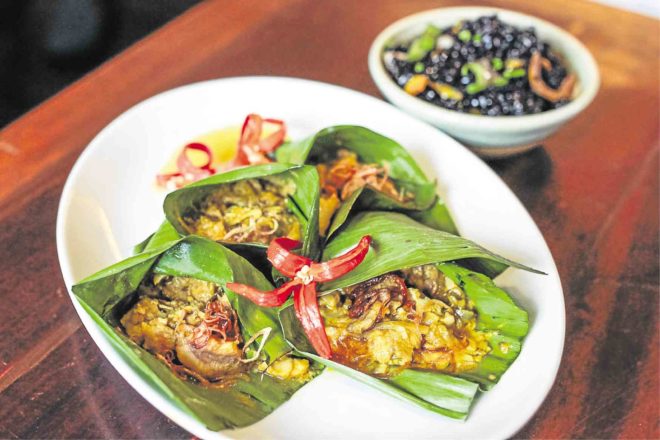
Cambodia’s ‘amok’ by Amy Besa
Cambodia’s most famous dish is fish amok, a lightly sweet and creamy fish curry cooked and presented in a banana leaf bowl. Traditionally, amok calls for freshwater fish and is served steamed. Amy Besa and her Purple Yam culinary team recreated the dish using catfish or hito.
“Amok is prepared like a mousse,” Besa said. “And you steam it in banana leaves.”
Using turmeric oil as base to make yellow curry, they cooked catfish fillet in the curry with fresh coconut milk and coconut nectar for a hint of sweetness. After being steamed in banana leaf cones, the amok was garnished with toasted shallots and ginger.
Besa and her team made it more special—and truly Pinoy— by serving the catfish amok with veggie-fried Ominio heirloom rice from the Mountain Province on the side.
“Amok is traditionally served with rice,” said Besa, who wrote a research on Southeast Asian cuisine for Oxford University Press reference book, “Savoring Gotham,” published in 2015. “We used Ominio rice because it complements the flavor of the curry.”
Cambodian Amok
250 g freshwater fish, catfish or hito
5 cloves garlic, minced
30 g ginger
30 g turmeric
2 stalks lemongrass
3 bulbs shallots
3 pc kafir lime leaves or 1 whole lime
4 pc whole black peppercorn
Salt to taste
1 tbsp fish sauce
2 tbsp coco nectar
1 pc red Thai chili
1 c vegetable il
½ c coconut cream
½ c coconut milk
Banana leaves
Clean fish by removing skin and bones. Cut into small chunks.
In a small sauce pot, make turmeric oil by adding vegetable oil, some of the turmeric, shallots, garlic and black peppercorn, and heat until oil is fragrant and yellow in color.
In a wok, on medium high heat, add turmeric oil. Sauté garlic, ginger, lemongrass, red Thai chili and shallots. Deglaze with coconut milk. Simmer. Add coco nectar, salt, fish sauce, lime zest and lime juice. Add fish chunks and poach slowly until halfway cooked, then remove from liquid. Add coconut cream and reduce until sauce is thick. Add half-cooked fish chunks and turn off heat and set a side.
Make round cups from banana leaves and stuff with the fish mixture. Steam for 4-5 minutes.
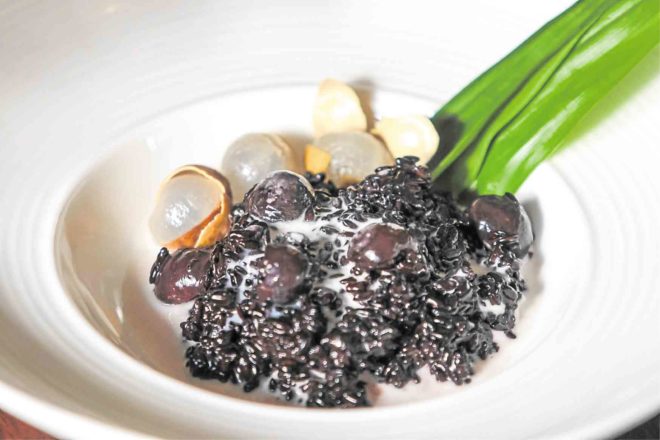

Laos’ sticky black rice porridge with longan by Amy Besa, Raphael Angelo Cristobal and Agnes Elizabeth Lim
Amy Besa and her team presented two popular desserts from Laos: Sticky Black Rice Porridge with Longan and Nam Kang Sai.
The sticky rice is mixed with longan fruit cooked in coconut milk, salt and sugar. Besa’s version makes use of Ominio heirloom rice from Mountain Province.
“The longan turns black when blended with the black rice,” Besa said. “The main characteristic of this rice dessert is the push-pull flavors of salt and sugar blending with fresh coconut milk for sweet harmony.”
Coconut milk is poured right before serving the dessert rice.
Laos’ iced dessert, nam kang sai, uses palm seed, grass jelly, grenadine, condensed milk, croutons and shaved ice. Instead of croutons, Purple Yam’s version has slices of Ominio bibingka. For the syrup, they concocted a Benguet strawberry and roselle syrup and soft pastilles instead of condensed milk.
“We don’t use condensed milk,” Besa said. “We instead boil down the milk and sugar to have that pastillas-like taste, consistency and sweetness.”
They also added their own tab tim krob (rubies in coconut milk) made of singkamas coated in grenadine and tapioca starch. Fresh melon cubes added to the refreshing taste.
Sticky Black Rice Porridge with Longan
2 c black rice (glutinous)
2 c water
2 tbsp sugar
Pinch of salt
3 pandan leaves
½ c coconut cream
½ c coconut milk
8 pc peeled and seeded longan
Soak rice in pot for 30 minutes. Boil rice with pandan leaves until cooked. Stir in coconut milk, salt, sugar and longan. Keep stirring until everything gets well incorporated at low heat. Make sure longan gets the color of the rice. Pour coconut cream before serving.

Nam kang sai:
1 tbsp candied singkamas with grenadine syrup
1 tbsp kaong
1 tbsp nata de coco
1 tbsp sweetened adzuki beans
5-7 pc diced grass jelly
Diced fresh melon
Toasted pinipig
Shaved ice
Homemade condensed milk:
1 c fresh milk
¾ c sugar
Sauce:
½ c strawberry jam
½ roselle jam
For condensed milk, combine milk and sugar in a heavy-
bottom sauce pot. Put on medium heat, constantly stirring while reducing. Keep an eye on your milk as it may overflow if it gets too hot. Reduce for 30 minutes until it thickens a bit. (It will thicken more once it cools.) Take off heat. Cool. Store in a jar and refrigerate.
For sauce, combine strawberry and roselle jam.
Assembly: Put all condiments except pinipig in a bowl or glass. Add ice on top of the condiments. Top with strawberry, roselle sauce, condensed milk, pinipig.
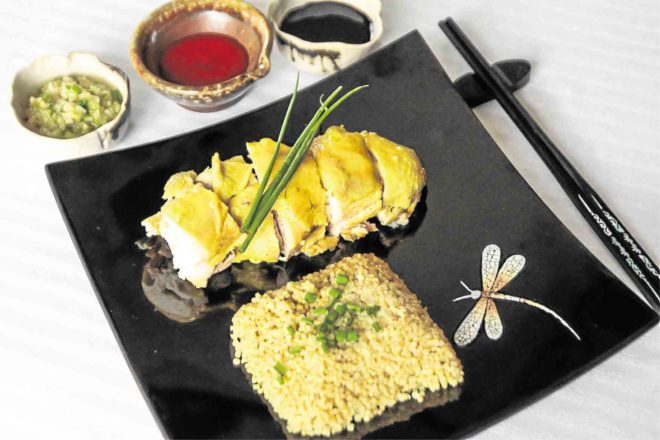
Singapore’s Hainanese Chicken Quinoa by Michelle Dinglasan-Tomacruz
Widely considered to be the national dish of Singapore, Hainanese Chicken Rice is one complete meal with all the flavors packed in the meat and aromatic rice. Instead of rice, chef Michelle Dinglasan-Tomacruz’s uses quinoa cooked in the same potent broth.
“Quinoa is a healthier alternative to rice,” Tomacruz said. “I’ve been serving quinoa in our household for some time now.”
Quinoa has more protein than rice. She cooks quinoa with the Hainanese stock just like cooking steamed rice. The chicken is served with chilli sauce, kecap manis and ginger garlic sauce.
Hainanese Chicken
1 whole fresh chicken
One knob of ginger (around 2 inches), sliced thick
One knob of turmeric (luyang dilaw), sliced thick
4 pc leeks cut into two inches
2 tbsp black pepper
6 c water
Sesame oil
Hainanese quinoa:
1 c washed quinoa
2 c Hainanese stock (broth where chicken was cooked)
Three sauces:
1/8 c chili sauce
½ c kecap manis (sweet soy sauce)
Ginger garlic sauce:
3 tbsp canola oil
2 tbsp sesame oil
9 tbsp finely minced young ginger
1 tbsp finely minced garlic
1 tbsp finely chopped spring onion
Salt to taste
Hainanese chicken: Put all ingredients including chicken in water. Cover pot. As soon as it boils, lower heat. Simmer for 1 hour with pot covered. Turn off heat. Leave meat in pot for another hour. Take out chicken and baste with sesame oil. Strain stock. Use stock to cook quinoa. Stock can also be served as soup. Chop chicken and serve with quinoa and three sauces.
Hainanese quinoa: Cook quinoa with Hainanese stock.
Ginger sauce: In a saucepot, heat ginger and garlic in oil. Do not brown. Cook until heated through. Turn off heat. Add salt, sesame oil and chopped spring onions.

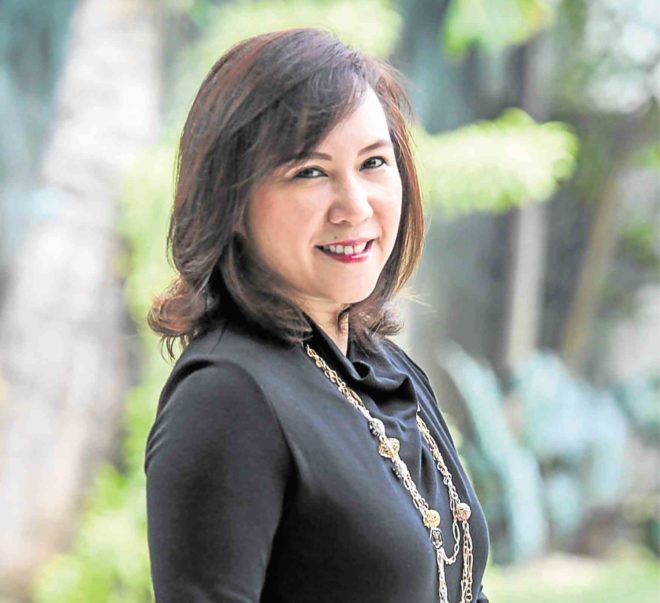
Myanmar pork curry with pickled mangoes by Michelle Dinglasan-Tomacruz
This pork dish is similar to the Philippines’ adobo but with a twist. It has pickled mangoes that add a nice sour-sweet aftertaste.
Tomacruz, who just came back from a tour to Myanmar, learned the recipe from the locals who serve this dish in the restaurants.
“The mangoes help thickens the sauce,” she said.
The Myanmar version has more curry sauce, while Tomacruz prefers to serve the pork a little dry with the sauce just on the side. In Myanmar, they use kasim (pork shoulder); Tomacruz uses pork belly which makes the dish a bit softer with the layering of fats in the meat.
Myanmar Pork Curry with Pickled Mangoes
1 k pork belly (liempo) cut into 2-inch cubes
1 big yellow onion, finely chopped
1/2 tsp Thai fish sauce
1 tsp finely minced ginger
1/2 tsp Asian chili powder
3 tbsp vegetable oil
7 c of water
2 tbsp chopped pickled mango
In a bowl, place all ingredients except water. Mix ingredients with bare hands. Marinate for 30 seconds. Put oil in a medium heat pot. Add pork with other ingredients. Sprinkle with 2 tbsp of water while cooking so pork doesn’t stick to pan. Cook and stir continuously until pork turns brown. Add 7 c of water. Boil. Simmer pork until soft. When sauce is around 2 cups, add pickled mangoes. Cook until sauce is reduced and thick.
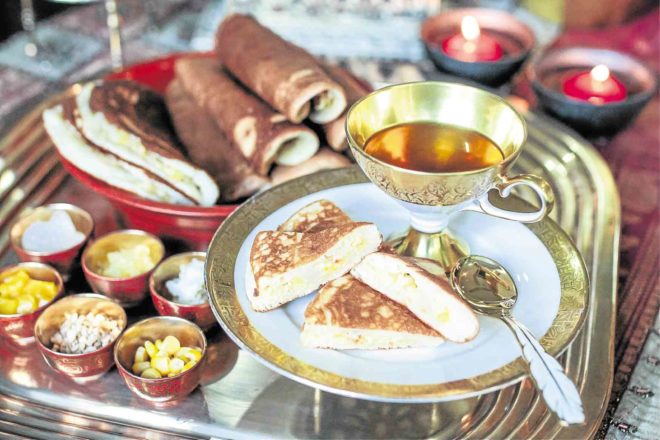
Brunei’s ‘apam balik’ by Dulce Magat-Gibb
Apam balik is a typical street food snack that looks like pancakes with a variety of filling. The traditional filling calls for peanuts and sugar. Dulce Magat-Gibb added macapuno, langka, pastillas and cheese to add some Filipino flavor to the snack.
“Street vendors typically sprinkle ingredients one at a time over the whole pancake rather than mixing all the ingredients together,” Gibb said. “But to make things easier, they can just stuff the desired ingredients inside the rolled pancake.”
Other possible fillings include grated chocolate or Nutella.
“Cook pancake longer for a crispier outside texture,” she said.
Apam Balik
Batter:
175 g flour
10 g cornstarch
2 tsp baking powder
½ tsp baking soda
½ tsp salt
150 g sugar
400 ml coconut milk
2 eggs
Filling:
55 g butter, softened
100 g toasted peanuts, coarsely chopped
120 g corn kernels, chopped
120 g macapuno, chopped
50 g fresh langka, chopped
120 g pastillas
120 g gouda cheese, grated
Filling: Mix all ingredients to blend. Set aside.
Mix all dry ingredients and form a well. Put coconut milk and eggs into the well. Whisk in wet ingredients into the dry until well blended. Batter should be the consistency of a very runny pancake batter.
Heat a nonstick pan over lowest heat. Pour a small ladleful of batter. Put tiny amounts of filling all over the pancake. Cook until batter on top has dried and bottom has achieved an even golden color.
Lift pancake from pan with spatula onto a cooling rack. While still hot, roll pancake with filling side facing inwards or simply fold in half.









































